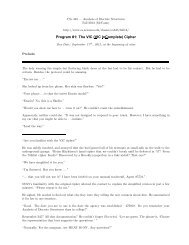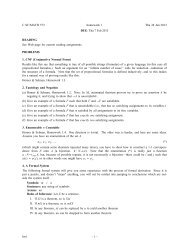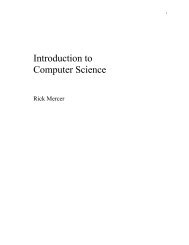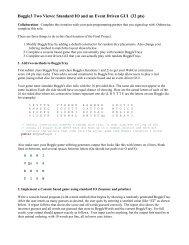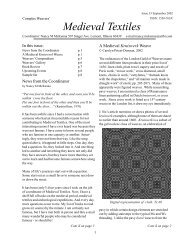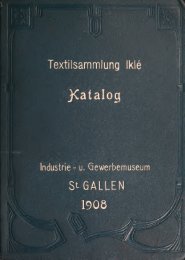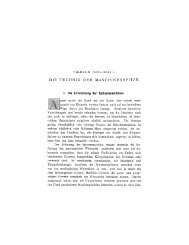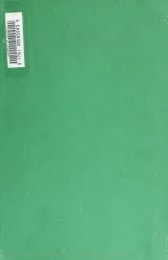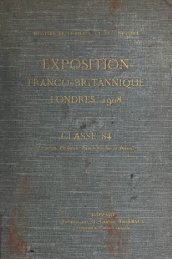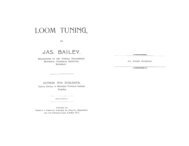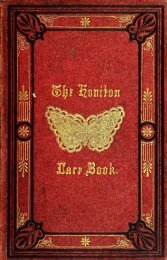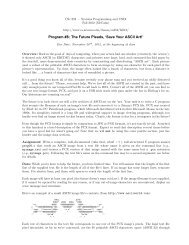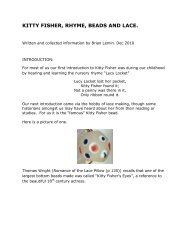The Priscilla Battenberg and point lace book; a collection of lace ...
The Priscilla Battenberg and point lace book; a collection of lace ...
The Priscilla Battenberg and point lace book; a collection of lace ...
You also want an ePaper? Increase the reach of your titles
YUMPU automatically turns print PDFs into web optimized ePapers that Google loves.
every stitch the needle is thrust through the loop<br />
above <strong>and</strong> back <strong>of</strong> the parallel thread, so that it is<br />
always held with the loop > in the twist cf the net<br />
stitch, <strong>and</strong> forms a part <strong>of</strong> the body <strong>of</strong> the <strong>lace</strong>.<br />
A very novel effect is produced by missing some<br />
<strong>of</strong> the loops <strong>of</strong> the network, <strong>and</strong> in the next row<br />
working the same number <strong>of</strong> stitches in the loops<br />
so formed. <strong>The</strong> result is a series <strong>of</strong> open spaces<br />
in the close' net work that is very odd. <strong>The</strong>se<br />
open spaces may be p<strong>lace</strong>d at regular intervals over<br />
the entire network, or may be so spaced as to<br />
form a design. In i"ig. 66 the iirst row is a series<br />
<strong>of</strong> close buttonhole stitches. <strong>The</strong> thread is then<br />
carried back to the opposite side, <strong>and</strong> a second row<br />
<strong>of</strong> buttonhole stitches over it is begun. Pour <strong>of</strong><br />
these stitches are p<strong>lace</strong>d, <strong>and</strong> the next four omitted.<br />
<strong>The</strong> following six<br />
are worked, <strong>and</strong><br />
the next four<br />
omitted. <strong>The</strong> next<br />
four are worked.<br />
<strong>The</strong> next row is<br />
worked without<br />
any omissions.<br />
When the open<br />
spaces are reached,<br />
Fl6. 66. Tenetian Stitoh.<br />
the same number <strong>of</strong> stitches are worked in each as<br />
were omitted in the former row. In the following<br />
row the open space is left just between <strong>and</strong> below<br />
the two spaces <strong>of</strong> the upper row. Another com-<br />
plete row follows. <strong>The</strong> sixth rOw is a repetition<br />
<strong>of</strong> the second row.<br />
Double Venetian or Cobweb Stitch.<br />
One <strong>of</strong> the most beautiful <strong>and</strong> popular <strong>of</strong> all the<br />
<strong>lace</strong> stitches is the double Venetian. This is made<br />
in the same way<br />
as the single Venetian,<br />
except<br />
that, instead <strong>of</strong><br />
a single button-<br />
hole stitch in<br />
each loop, two<br />
are used. <strong>The</strong><br />
two stitches aid<br />
each other in<br />
FI(S. 67.<br />
keeping the thread firmly in p<strong>lace</strong>, <strong>and</strong> make a<br />
very regular, substantial filling, that has a very<br />
fine <strong>lace</strong>-like appearance. <strong>The</strong> loop between the<br />
stitches is left loose <strong>and</strong> held in p<strong>lace</strong> with a pin<br />
as shown in the illustration.<br />
Cobweb Stitch,<br />
26<br />
This stitch may also be made with three button-<br />
hole stitches in<br />
W o r k e d in<br />
each loop, as shown in Fig. 68.<br />
'<br />
this way the<br />
effect is de-<br />
cidedly close<br />
<strong>and</strong> solid, un-<br />
less the loops<br />
are made suf-<br />
ficiently large<br />
to aUow ample<br />
space for the<br />
three stitches.<br />
Fig. 68. Venetian Stitch.<br />
Darned Figures on Venetian Background.<br />
After a space has been filled with the plain,<br />
close Venetian stitch, it may be embellished in a<br />
variety <strong>of</strong> ways, <strong>and</strong> so made very effective <strong>and</strong><br />
rich in appearance. With a fine linen floss, or<br />
other loosely twisted thread, pretty tufts or spots<br />
may be darned over two rows <strong>of</strong> the Venetian<br />
background. When worked at regular intervals,<br />
they add greatly to the richness <strong>of</strong> the work.<br />
Stars <strong>and</strong> trefoils in bullion stitch, buttonholed<br />
rings, <strong>and</strong> other fancy stitches may also be used.<br />
When a very solid, cloth-like effect is desired,<br />
the Venetian stitch is worked with the net stitches<br />
very close together. Only sufficient room is left,<br />
for the placing <strong>of</strong><br />
the net stitch <strong>of</strong><br />
the succeeding<br />
row. <strong>The</strong> straight<br />
thread aids also<br />
'in producing an<br />
almost solid effect.<br />
This compact<br />
method <strong>of</strong> work-<br />
ing this stitch is<br />
seen most frequently in Venetian <strong>lace</strong>, where it is<br />
used as a filling for leaves, scrolls, <strong>and</strong> various<br />
parts <strong>of</strong> the design to be thrown out most effect-<br />
ively by the open background <strong>of</strong> Raleigh bars, or<br />
the even regular net ground.<br />
Spider or Wheel Stitch.<br />
Fig. 69. Venetian Stitch.<br />
This is a very rich <strong>and</strong> beautiful filling for large<br />
spaces. Beginning at the upper left corner, a diag-<br />
onal line is laid across the space at an angle <strong>of</strong><br />
forty-five degrees. <strong>The</strong> thread is then returned,<br />
but without twisting, to the first end <strong>of</strong> the diago-<br />
nal line, so that the two threads form a double line



